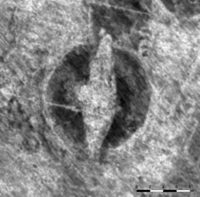 On Friday, June 26th, Norway’s Minister of Climate and Environment Sveinung Rotevatn broke ground on the country’s first excavation of a Viking ship burial mound in 100 years. The newly-discovered Gjellestad Ship comes slow on the heels of the Oseberg Ship which was excavated in 1904. Archaeological methodology, technology and understanding is a completely different universe 116 years later, so even though the Gjellestad Ship is known to be in a far worse state of preservation than the exquisite Oseberg (now on display at the Viking Ship Museum in Oslo), methods like micromorphology, DNA analysis, soil analysis and stable isotope analysis will give archaeologists a far richer picture of the ship burial, its contents and context.
On Friday, June 26th, Norway’s Minister of Climate and Environment Sveinung Rotevatn broke ground on the country’s first excavation of a Viking ship burial mound in 100 years. The newly-discovered Gjellestad Ship comes slow on the heels of the Oseberg Ship which was excavated in 1904. Archaeological methodology, technology and understanding is a completely different universe 116 years later, so even though the Gjellestad Ship is known to be in a far worse state of preservation than the exquisite Oseberg (now on display at the Viking Ship Museum in Oslo), methods like micromorphology, DNA analysis, soil analysis and stable isotope analysis will give archaeologists a far richer picture of the ship burial, its contents and context.
The Gjellestad ship was discovered during a ground penetrating radar scan of a field in Halden, southeastern Norway, in October of 2018. The GPR picked up the distinctive shape of the 65-foot long ship set within the circular perimeter of what had once been a burial mound on top of it, lost over centuries of agricultural work. It was incredibly close to the surface, just 1.6 feet underground, and therefore incredibly close to destruction.
In September of last year, Norwegian Institute for Cultural Heritage Research (NIKU) archaeologists dug a test pit and retrieved a sample of the wood from the keel to get an idea of the ship’s age and condition. There was good news and there was bad news. The good news was the ship was confirmed dendrochronologically to be a Viking ship, the timber for its keel felled between the late 8th century and the start of the 10th century. The bad news was it is being devoured by fungal growth and very close to destruction.
 Norway allocated funds for an emergency excavation of the Gjellestad Viking Ship to recover whatever of the ship and its context can be recovered before it all rots away. Now that the official ground-breaking is out of the way, archaeologists will begin the official excavation on Monday. Stage one entails the painstaking sifting of all the topsoil above the ship to a depth of about one foot. The hope is there might be some iron rivets, boat fittings, artifacts that were churned up out of their original positions by ploughing.
Norway allocated funds for an emergency excavation of the Gjellestad Viking Ship to recover whatever of the ship and its context can be recovered before it all rots away. Now that the official ground-breaking is out of the way, archaeologists will begin the official excavation on Monday. Stage one entails the painstaking sifting of all the topsoil above the ship to a depth of about one foot. The hope is there might be some iron rivets, boat fittings, artifacts that were churned up out of their original positions by ploughing.
The ship is bisected by a drainage ditch, so the team is taking advantage of the landscape in the project planning. Working under a protective tent that covers the entire length and width of the ship, the team will first excavate the bow which is about 23 feet long tip to drainage ditch. In the second phase of excavation, they will unearth the bow and the burial chamber which is expected to be about in center of the ship.
The team is hoping to find grave goods, but there is evidence that the mound was looted long ago. Grave robbers dug a tunnel down the center of the ship so all the more obvious portable wealth like precious metals and jewelry from the burial chamber is probably gone. On the plus side, utensils, household goods, pottery and the like placed in the bow and stern were likely left behind.
The full excavation is expected to take about five months. It will not be open, but archaeologists will plan guided tours, pandemic measures permitting.